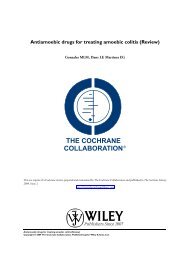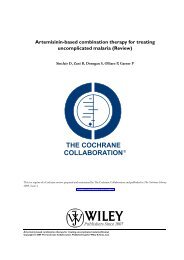Legislative smoking bans for reducing secondhand smoke exposure ...
Legislative smoking bans for reducing secondhand smoke exposure ...
Legislative smoking bans for reducing secondhand smoke exposure ...
Create successful ePaper yourself
Turn your PDF publications into a flip-book with our unique Google optimized e-Paper software.
Bartecchi 2006 (Continued)<br />
Outcomes AMI hospitalization rates pre and post ban inside, and outside city limits of Puebloand a neighbouring county (El<br />
Paso County); adjustment <strong>for</strong> seasonality was made<br />
Biochemical verification: No.<br />
Notes<br />
Biener 2007<br />
Methods Country: USA<br />
Setting: Boston and other Massachusetts cities<br />
Design: Observational study, cross-sectional surveys, pre and post-ban surveys. Analysis: P values based on chi 2 test.<br />
Bivariate comparisons and multinomial logistic analysis to determine independent predictors of changes from preto<br />
post-law.<br />
Participants Baseline sample: Sub-sample of all baseline <strong>smoke</strong>rs and recent quitters and all young adults between 18-30 yrs from<br />
large longitudinal study.<br />
Follow up: Cohort 986. 83 live in Boston and 903 live in other Massachusetts towns without <strong>smoke</strong>-free regulations.<br />
57% of all the baseline <strong>smoke</strong>rs who completed the follow-up interview. Only <strong>smoke</strong>rs who completed both the<br />
baseline and follow-up surveys and whose follow-up interview occurred after the implementation of the <strong>smoking</strong><br />
ordinance were included in the analysis. This excluded 316 eligible respondents who lived in one of 78 Massachusetts<br />
cities or towns that had a <strong>smoke</strong>-free bar regulation in place prior to July 2004.<br />
Sample characteristics: Boston n=83, Female: 54.8% 95% CI (42.3 to 66.7), Age yrs: 31 and over 71.9% (58.9,<br />
82.5). Education: Some college or more: 48.4% (36.7, 60.2).<br />
Other MA town % (95% CI), n=903. Female 53.9% (50 to 57.8), Age 31 and over: 75.6% (72.0 to 78.8). Education:<br />
Some college or more: 50.1%(46.2 to 54.0).<br />
No significant difference in demographics such as age, gender, ethnicity, education or marital status or in <strong>smoking</strong><br />
patterns, patronage patterns or support <strong>for</strong> the <strong>smoking</strong> ban at baseline between those <strong>smoke</strong>rs at baseline who<br />
responded at follow up and those who did not.<br />
Differences between participants in Boston and other Massachusetts (MA) towns at baseline: More minorities (48.4%<br />
vs 11.4%, 95% CI), unmarried people (76.6% vs 51.5%, 95% CI), less heavy <strong>smoke</strong>rs (27% vs 39.9%, 95% CI)<br />
and more support <strong>for</strong> the <strong>smoking</strong> ban at baseline in Boston than in other MA towns (15.7% vs 7.4%, 95% CI).<br />
Interventions Evaluated a <strong>smoke</strong>-free workplace ordinance in May 2003 in Boston. It prohibited <strong>smoking</strong> in all workplaces including<br />
bars and restaurants.<br />
Outcomes Self-reported <strong>exposure</strong> to SHS at home<br />
Self-reported <strong>smoking</strong> at home<br />
Biochemical verification: No<br />
Notes Other outcomes include compliance with <strong>smoking</strong> <strong>bans</strong>, economic impact such as bar patronage and support <strong>for</strong> the<br />
implementation of <strong>bans</strong>.<br />
<strong>Legislative</strong> <strong>smoking</strong> <strong>bans</strong> <strong>for</strong> <strong>reducing</strong> <strong>secondhand</strong> <strong>smoke</strong> <strong>exposure</strong>, <strong>smoking</strong> prevalence and tobacco consumption (Review)<br />
Copyright © 2010 The Cochrane Collaboration. Published by John Wiley & Sons, Ltd.<br />
26








